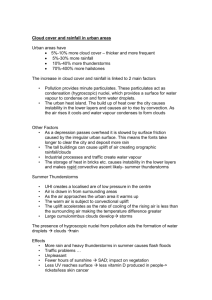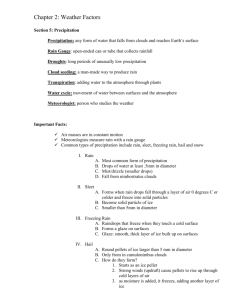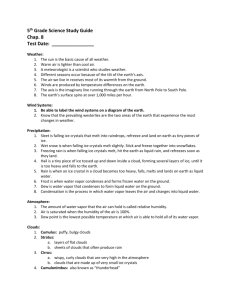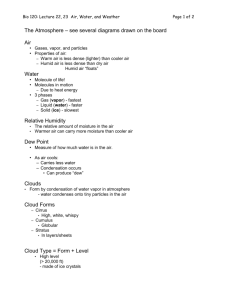Measuring Weather
advertisement
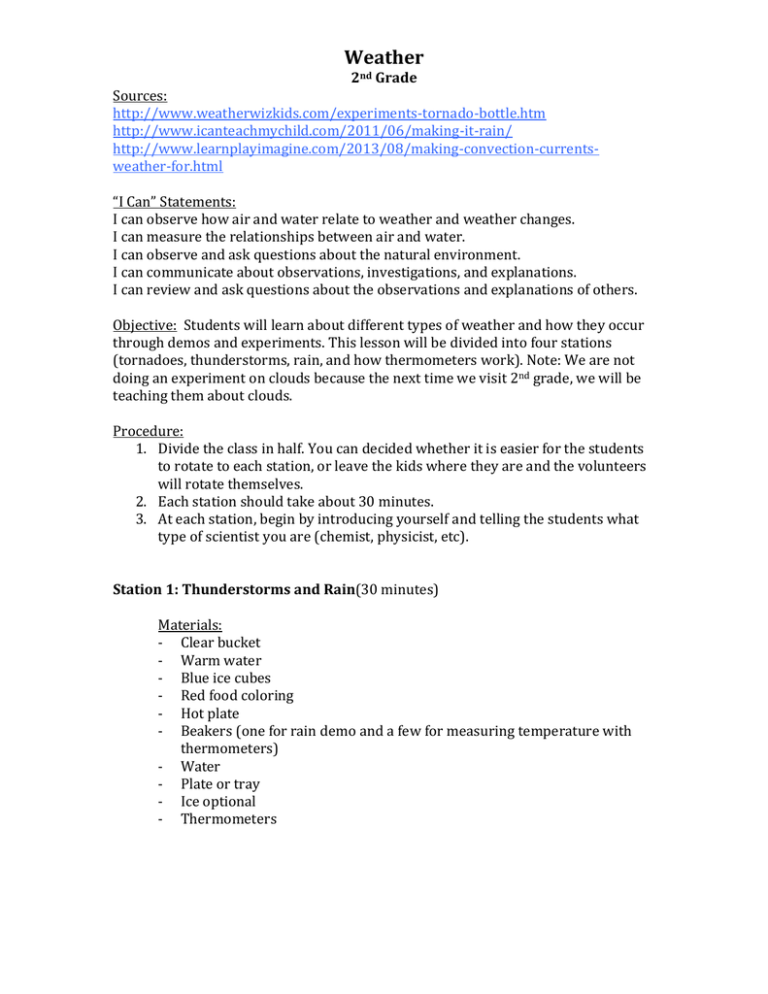
Weather 2nd Grade Sources: http://www.weatherwizkids.com/experiments-tornado-bottle.htm http://www.icanteachmychild.com/2011/06/making-it-rain/ http://www.learnplayimagine.com/2013/08/making-convection-currentsweather-for.html “I Can” Statements: I can observe how air and water relate to weather and weather changes. I can measure the relationships between air and water. I can observe and ask questions about the natural environment. I can communicate about observations, investigations, and explanations. I can review and ask questions about the observations and explanations of others. Objective: Students will learn about different types of weather and how they occur through demos and experiments. This lesson will be divided into four stations (tornadoes, thunderstorms, rain, and how thermometers work). Note: We are not doing an experiment on clouds because the next time we visit 2nd grade, we will be teaching them about clouds. Procedure: 1. Divide the class in half. You can decided whether it is easier for the students to rotate to each station, or leave the kids where they are and the volunteers will rotate themselves. 2. Each station should take about 30 minutes. 3. At each station, begin by introducing yourself and telling the students what type of scientist you are (chemist, physicist, etc). Station 1: Thunderstorms and Rain(30 minutes) Materials: - Clear bucket - Warm water - Blue ice cubes - Red food coloring - Hot plate - Beakers (one for rain demo and a few for measuring temperature with thermometers) - Water - Plate or tray - Ice optional - Thermometers 1. Rain Demo a. Prepare the rain demonstration before the lesson begins. b. Explain to the students how rain is formed: The hot water at the bottom is evaporating and turning into a gas or water vapor. That water vapor rises in the air and hits the cold pan. The cold from the pan turns the water vapor back into raindrops. The hot water represents water on the ground, and the cold tin represents clouds. 2. Thunderstorms a. Prepare large clear bins with warm water (fill bins about half way). b. Give a basic explanation of thunderstorms. A thunderstorm is a storm with lightning and thunder. Thunderstorms are started when warm air quickly rises. Heat naturally rises, and when colder air comes through, the heat rises faster. Lightning is formed from lots of small pieces of ice hitting each other. This creates a charge. When enough ice pieces hit each other and there is enough electrical change, lighting occurs. Lighting hits the ground so fast that it pushes the air out of the way, which makes a sound called thunder. Thunder is what you hear during thunderstorms. 3. Show students the blue ice cubes, and tell them that they represent cold air. 4. Have a student place a few ice cubes in the water at one end of the bin, then have another student add a few drops of red food coloring at the other end of the bin. Explain to the students that the red food coloring represents warm air. 5. After a few minutes, the red and blue will begin to mix. Have the students look and observe the colors mixing from the top, and the side. (a picture of experiment is below) 6. Ask the students what they see. If no one mentions how the red color is on top of the blue, point it out and ask the students why they think this happened (heat rises). Picture by: Allison Sonnier; http://www.learnplayimagine.com/ 7. If time allows, let the students use the thermometers to measure the temperatures of different beakers of water. Beakers should have varying temperatures. Station 2: Air Pressure (Making Barometers) (15 minutes) - Materials: Cloud Demo Large Balloon Rubber Bands Tape Straws Paper Jar 1. Show the students the cloud demonstration, and explain that the ski is clear with no clouds when there is high pressure. Clouds are formed when the air pressure is low. a. Three things that are needed to make a cloud. Moisture or water vapor, dust/pollen, and change in temperature/pressure. The moisture in the air condenses (or turns into a liquid) when the pressure and temperature changes from high to low. The liquid collects onto the dust and pollen in the air, and that is why it looks cloudy. When there is high pressure, it is a nice and clear day outside. When there is low pressure, it is cloudy outside. 2. Explain to the students that a Barometer is used to measure the air pressure. a. Cut the balloon so that there is a wide opening. Cover the opening of the jar with the cut balloon, and use the rubber band to secure it in place. b. Tape a small part of the end of a straw to the top of the jar. Tape should be 1 inch away from the straw end that is on the balloon. (Pictured above) c. Place the barometer by a wall. Then tape a piece of paper to the wall behind it. Draw a line on the paper that matches the height of the straw. Then draw a line above and below that line a few centimeters away. The top line represents high pressure, and the bottom line represents bad weather. (When the atmospheric pressure is low, the weather is typically bad. When the atmospheric pressure is high, the weather is typically good). (Pictured below). 3. Explain to the students that they should record the height of the straw everyday and record the weather to see if this is true.

